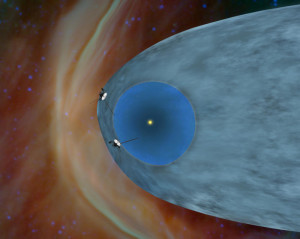This story really made my heart stop beating, just for a second. Humankind’s farthest-reaching spacecraft, Voyager 1, is really close to leaving the magnetic field of our sun. What that means is that Voyager 1 is the farthest away from the sun that anything man-made has ever been. An artist had to create his own rendering of the picture.
The sun is the dot in the middle of the blue circle. You can imagine Earth being somewhere near that dot. Everything else, all the other colors, represents what else is out there in the Milky Way.
Voyager 1 was launched by NASA, along with its identical twin, Voyager 2, in 1977. Since then, Voyager 1 has made it 11 billion miles away from the sun. Voyager 2, however, wasn’t so lucky. It was the little brother who was born two seconds after his faster one. It’s still going, but it’s only made it nine billion miles away. At the rate they’re both going, Voyager 1 will make it to the finish first, receive all the media attention, and his straggling twin will get a mere mention in the magazines. Scientists aren’t sure whether that finish will happen months or years from now.
While Voyager 1 has been getting closer to edge of the heliosphere, which is defined by the extent of the sun’s magnetic field (the blue circle and everything in it in the drawing above), researchers have only now become certain that it’s definitely on its way to crossing over into interstellar space. Soon. Pretty soon.
Using its on-board charged-particle and magnetometer instruments, Voyager 1 was able to send data back to NASA since 1977 on the movement of cosmic rays, which are the particles, and the magnetic field. The scientists were looking for three signs of the so-called interstellar magnetic highway:
- Charged particles disappear, apparently leaving the heliosphere as they zoom out along the solar magnetic field.
- Charged particles zoom in, apparently from outside of the heliosphere.
- There is an abrupt change in the direction of the magnetic field.
Burlaga L.F., Ness N.F. & Stone E.C. (2013). Magnetic Field Observations as Voyager 1 Entered the Heliosheath Depletion Region. , Science, DOI: 10.1126/science.1235451
Krimigis S.M., Decker R.B., Roelof E.C., Hill M.E., Armstrong T.P., Gloeckler G., Hamilton D.C. & Lanzerotti L.J. (2013). Magnetic Field Observations as Voyager 1 Entered the Heliosheath Depletion Region., Science, DOI: 10.1126/science.1235721
Stone E.C., Cummings A.C., Mcdonald F.B., Heikkila B.C., Lal N. & Webber W.R. (2013). Voyager 1 Observes Low-Energy Galactic Cosmic Rays in a Region Depleted of Heliospheric Ions., Science, DOI: 10.1126/science.1236408
